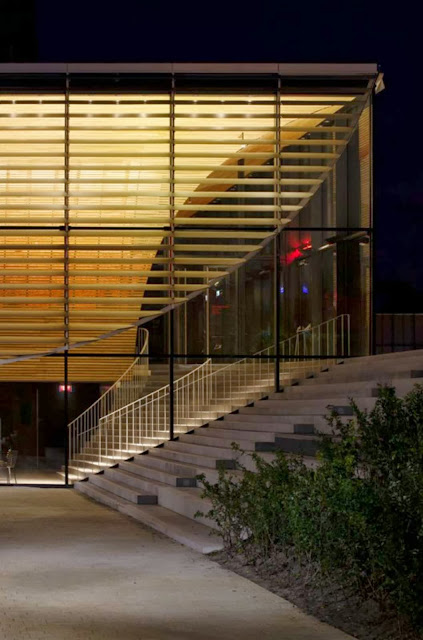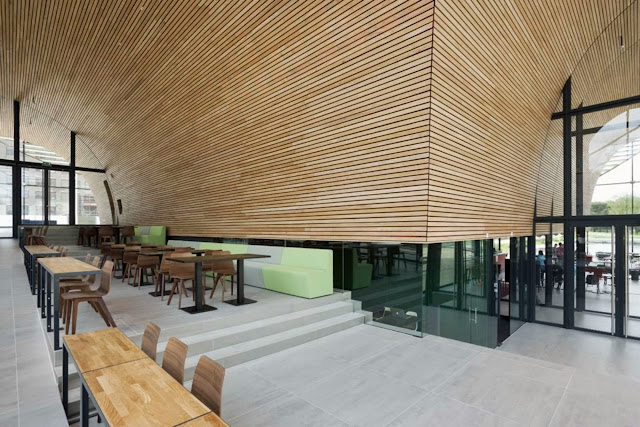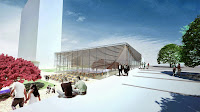The Erasmus Pavilion is the central meeting point on the new campus of the Erasmus University Rotterdam. It's a place to have lunch, attend a lecture, study with a group or enjoy a graduation drink.
The basic idea, therefore, was to design a space where people like to meet. For us, that starts with a really good cup of coffee. So we took inspiration from the grand café, a basic feature of which is to have a high, light space combined with lower, intimate spaces around the bar. Collaborating with De Zwarte Hond (DZH), we gave our building these varied spatial experiences. We also designed it to react to, and be in harmony with, daylight and the seasons.
On warm summer evenings, the building is open, transparent and connected to its context. On a cold, rainy winter day, the building is a closed and inviting refuge, a place to warm up with a cup of hot chocolate. To achieve this adjustability, we designed a façade composed of dynamic lamellas that can open and close, letting in varying amounts of light. We supplemented this with different types of lighting to amplify the effect.
Façade flexibility
We approached the design with the idea of creating a building that can actively change its façade – not only to adapt to the weather and the cycle of seasons, but also to allow an adjustable level of intimacy inside, depending on the events taking place there.
Through opening or closing the dynamic lamellas, users can determine how much daylight comes in. This leads to a reduction in energy consumption, but it also enables the level of openness of the building to be adjusted at will. The curved lines of the lamellas that sweep across the four faces of the façade are based on the path of the sun.
They moderate the amount of natural light and heat according to the sun’s orientation. The dynamic façade means that the appearance of the building continuously changes depending on the events inside and the weather outside. It is therefore animated by the vibrant rhythm of the student centre’s life, which it makes visible to the surrounding public spaces.
Light and lamellas
The façade and lighting can be used in various ways to create many different effects and atmospheres. The aluminium lamellas can be opened from 0 degrees (fully closed) to 120 degrees (sun shining in). The wooden ceiling can be lit by uplighters, and so accentuated, and paired with either open or closed lamellas. Lighting the red wall of the theatre box causes the pavilion ceiling to glow like a lantern.
Positioning all ‘dark-space’ programmes (those requiring an absence of daylight) in the building’s heart preserves its transparency. The logistical core is positioned here, with a multipurpose auditorium that offers space for lectures, performances and debates. This distribution of functions creates a considerable flexibility of use, which was essential for this project.
Low-consumption landmark
A compact building volume, the positioning of the mass in the centre core and the careful orientation of the programme towards the sun combine with an active façade, triple-glazing, solar panels on the roof, natural ventilation, and flexible zoning to make this transparent building a true low-consumption landmark.
The wooden ceiling presented its own challenges. Because the curves are different (with no 45 degree angles), the corner detailing was very tricky. By designing every single wooden plank individually in 3D, we helped the contractor to successfully achieve precise detailing on site. These one-of-a-kind interventions have resulted in an iconic building which is also energy neutral. Seen from outside, the pavilion has an enigmatic, shifting character, its dynamism signalling its interior programme like a beacon. Description from the architects.
Location: Rotterdam, The Netherlands
Architect: Powerhouse Company
Partner in charge: Nanne de Ru
Collaboration: De Zwarte Hond
Project Team: Nanne de Ru, Willem Hein Schenk (dZH), Stefan Prins, Sander Apperlo, Sybren Woudstra, Anja Lübke (dZH), Anne Larsen, Sijmen de Goede (dZH), Søren Harder Nielsen
Structural Engineering: Pieters Bouwtechniek
Installation Engineering: moBius Consult
Contractor: Lokhorst Bouw
Contractor Interior: Punt Interieurbouw
Supervisor Masterplan: Campus Juurlink+Geluk in collaboration with Sputnik
Size: 1700 m²
Budget: € 5.200.000
Year: 2013
Client: Erasmus University Rotterdam
Imagery: Christian van der Kooy



















